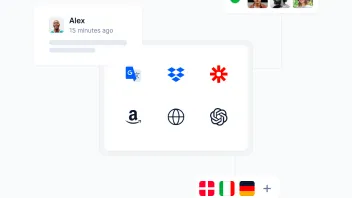Localization Quality Assurance: Your In-Depth Guide
The first thing you’ll notice about localization: it’s messy. Mistranslations, typos, and omissions. Broken layout and encoding errors.
Well, maybe not that last thing, but you get the idea. To avoid the aforementioned horrors, conduct localization quality assurance (LQA).
And we’ll help you along the way.
Pro tip: To automate and manage your localization QA process, use a professional localization management suite – Centus.
What is Localization Quality Assurance (LQA)?
Localization quality assurance (LQA) is the process of making sure that localized content is accurate, culturally appropriate, and visually consistent. Its purpose is to identify and fix issues that may arise during translation and localization—such as linguistic mistakes, layout problems, or cultural inaccuracies—before the content goes live.
In short, LQA acts as the final review stage before content is released in a new market, ensuring it meets both local expectations and brand standards
Types of Localization Quality Assurance
Localization QA includes several specific areas of focus. Each one addresses different risks that could affect how translated content is received and functions in a new market.
Linguistic QA
Linguistic QA is about checking the accuracy, grammar, and tone of translated content. Native speakers or trained linguists review the text for:
- Grammar, spelling, and punctuation
- Terminology consistency
- Proper tone and register
- Cultural appropriateness
The goal is to make sure the content reads naturally and meets audience expectations.
Visual QA
Visual QA ensures that layout and design elements are preserved after translation. This includes:
- Text alignment and spacing
- Overflow or truncation issues
- Image/text alignment
- Font consistency
It helps maintain a clean, functional presentation across all languages.
Functional QA
Functional QA tests whether localized software or digital content works correctly. Testers verify that:
- Buttons, menus, and links function properly
- Navigation behaves as expected
- No bugs were introduced during localization
For software, apps, or games, this step ensures nothing breaks when switching languages.
Performance QA
Performance QA checks that the localized product runs smoothly. This includes:
- Load times
- Stability
- Responsiveness
The aim is to match the performance of the original version, so users in any language enjoy the same experience.
8 Best Practices for Localization Quality Assurance
1. Know What Localization Actually Means
Localization is more than just translating words. You need to make content feel natural to local audiences by adjusting tone, cultural references, humor, and images.
Make sure your QA team knows the difference between translation and localization. Getting every word right doesn't matter if your content sounds weird to local readers. Work with native speakers who understand your target market—they'll catch things you miss.
2. Set Up a Clear QA Process
Good quality control needs organization. Plan out how you'll review content, who handles each step, and what tools you'll use.
Write down your standards: What's an error? What's just a style choice? When does something need to be redone? Start with a simple process and gradually add complexity.
Skilled QA engineers can take this even further by creating automated tests, leaving the manual, time-consuming workflows only for non-trivial tasks like reviewing contextual meaning or cultural adaptation.
Give yourself enough time for revisions—rushing QA means missing problems. Good reviewers with enough time work better than long checklists used in a hurry.
3. Check Accuracy and Meaning
Even good translators can make mistakes when the context isn't clear. Look at whether each language version keeps the original meaning—not just word-for-word but the whole message and tone.
Pay extra attention to phrases that mean different things, technical terms, or marketing copy. If something sounds off or doesn't match your brand, it probably needs fixing.
4. Don't Skip Grammar and Spelling
Good content falls flat when it's full of mistakes. Always check grammar, punctuation, and spelling—ideally have someone else look it over too.
Use native speakers for proofreading when you can. Spell checkers help but don't catch everything. If you're working on different devices or screen sizes, test those too—things can look very different across platforms.
5. Watch Out for Cultural Problems
Cultural mistakes kill localization projects. Small things like colors, symbols, or tone can feel wrong—or even offensive—to local audiences.
Check if your images, word choices, and references make sense in your target region. When in doubt, ask a native speaker or someone who knows the area well. Jokes and wordplay are risky. Most of the time, it's better to skip the humor than confuse people.
6. Test How Everything Looks
Your localized content won't work if the layout breaks. Long German or Finnish words can bust out of buttons or mess up designs. Translated text needs to fit into your existing design without looking squished or crooked.
Don't assume fonts will show all characters—many don't. Layout also changes for right-to-left languages or different punctuation rules. Always check the final version on different devices before you publish.
7. Get Real User Feedback
QA isn't done until real users weigh in. Localization isn't just about perfect grammar—it's about whether your message connects and feels natural.
Listen to what users say about your localized version. Are they confused? Do they complain about weird phrases or missing information? Use their feedback to improve next time. Real testing beats guessing.
8. Use Tools That Actually Help
Automated tools can catch basic problems like untranslated text or formatting issues. But don't depend on them completely—computers can't judge tone or clarity.
Tools like translation management systems and translation memory help with workflow, especially for multiple languages or big projects. Pick technology that fits how you work, not the other way around.
Tip: Use a robust localization platform like Centus to centralize your localization efforts and manage quality assurance from start to finish.
Get the week's best content!
By subscribing, you are agreeing to have your personal information managed in accordance with the terms of Centus Privacy Policy ->
Keep learning

12 min. read
Manual and Automated Localization Testing Explained

8 min. read
Key Localization Challenges and Solutions in 2025
10 min. read
What Is UI and UX Localization

12 min. read
How to Build a Localization Workflow
11 min. read
What Is Localization? A Comprehensive Overview
16 min. read